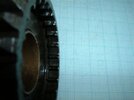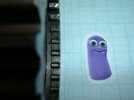Matty,
I’m glad there is at least one box out there with correct meshing. Perhaps there were only ever two that are incorrect. That would be just my luck.
While you have your new box in bits, please can you measure the depths from the joint face:
A) to the output bearing inner race without the output gear in place,
B) to the face of the output gear when this is in place in the bearing.
On my box, these are 135.8mm and 110mm respectively.
Still haven’t got mine back together yet…..I’m having the kick start stop boss welded........(Kick start stop sounds very strange)
Merry Christmas
Tatty
I’m glad there is at least one box out there with correct meshing. Perhaps there were only ever two that are incorrect. That would be just my luck.
While you have your new box in bits, please can you measure the depths from the joint face:
A) to the output bearing inner race without the output gear in place,
B) to the face of the output gear when this is in place in the bearing.
On my box, these are 135.8mm and 110mm respectively.
Still haven’t got mine back together yet…..I’m having the kick start stop boss welded........(Kick start stop sounds very strange)
Merry Christmas
Tatty





